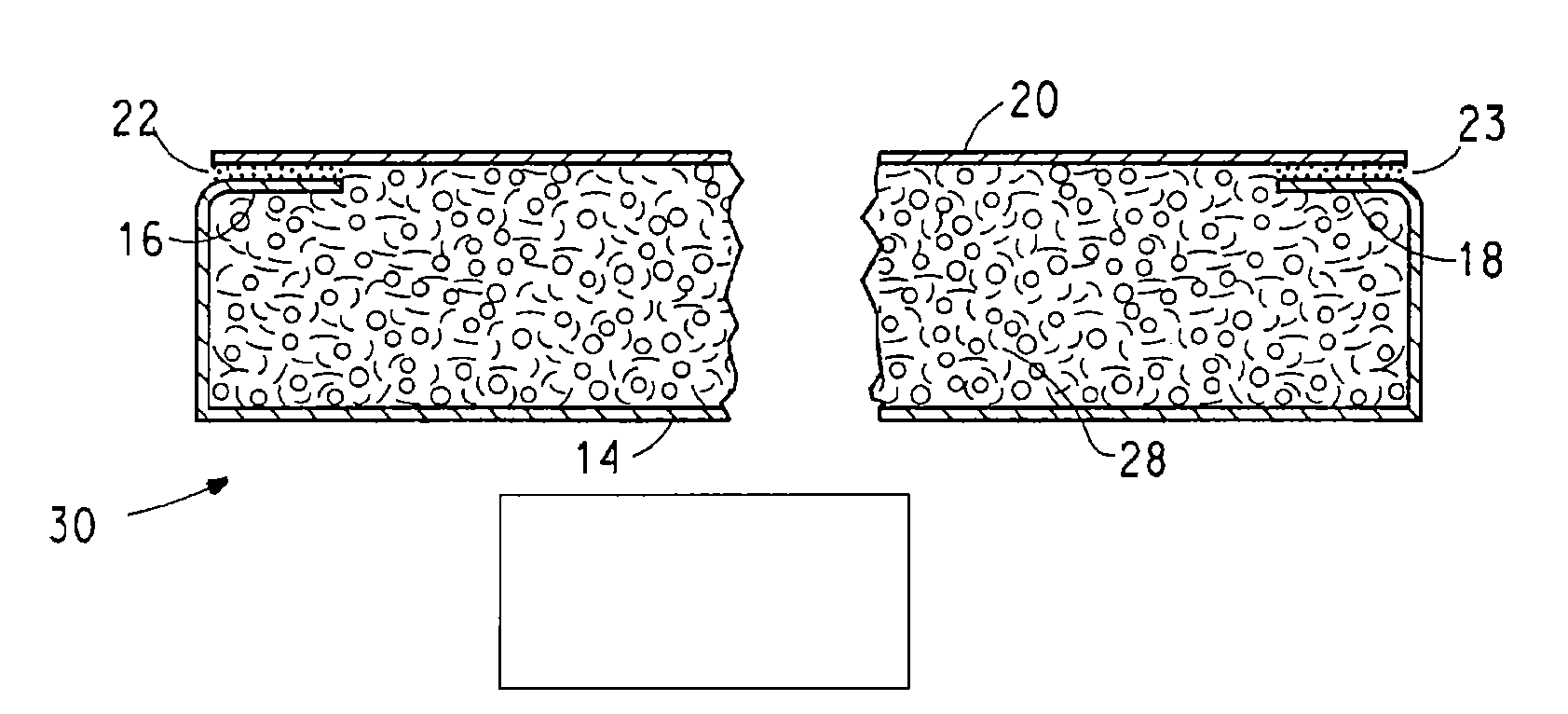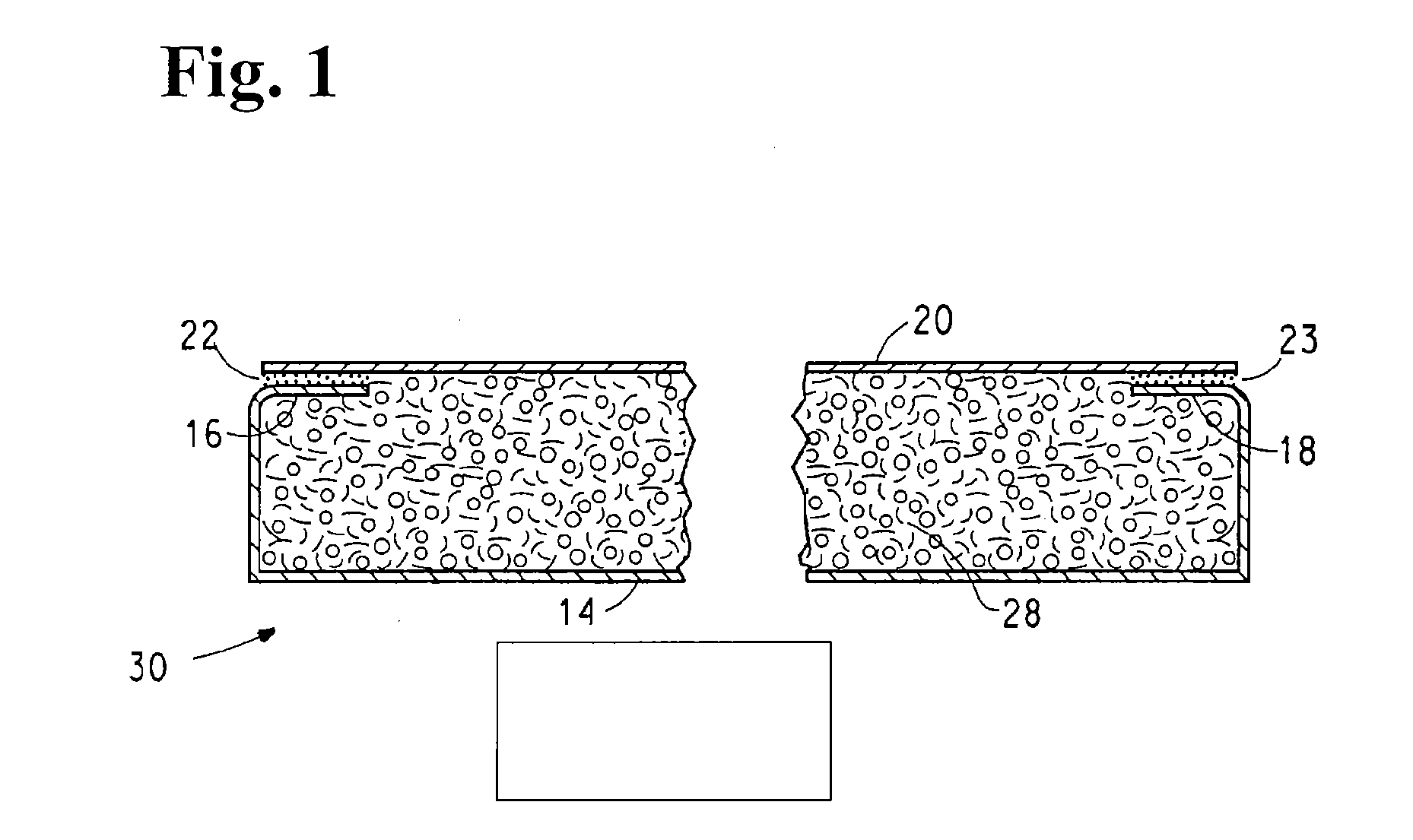Non-woven glass fiber mat faced gypsum board and process of manufacture
a technology of gypsum board and glass fiber mat, which is applied in the field of gypsum board, can solve the problems of paper facing not being able to provide, affecting the mechanical strength of the paper, and being highly prone to degradation, so as to facilitate the extraction of excess water, and be ready to finish
- Summary
- Abstract
- Description
- Claims
- Application Information
AI Technical Summary
Benefits of technology
Problems solved by technology
Method used
Image
Examples
example 1
Hydrophobicity of Non-Woven Glass Fiber Mat
[0055]Non-woven glass fiber mats are prepared using a wet laid mat machine in the manner disclosed in U.S. Pat. No. 4,129,674, which is hereby incorporated in the entirety by reference thereto. The mats all employ JM Chop Pak E-glass chopped fibers produced by Johns Manville Corporation, Denver, Colo., and having an average fiber diameter of about 13 μm and an average fiber length of about 13 to 19 mm. Samples are prepared using two binder systems, namely Lubrizol Hycar 26138, an acrylic copolymer, and Lubrizol Hycar 26868, a styrene acrylic copolymer, and are applied with a curtain coating / saturation technique. Both binders are commercially supplied by Lubrizol Advance Materials of Cleveland, Ohio and further contain small amounts of a conventional urea formaldehyde cross-linker and a water repellant. Non-formaldehyde based crosslinkers can also be used. The mats all have a basis weight of about 2.2 lb / 100 square feet.
[0056]The hydrophobic...
example 2
Tensile Testing of Non-Woven Glass Fiber Mats
[0058]Non-woven glass fiber mats are prepared to determine the effect of binder type on the tensile strength of the mats against delamination. Table II below sets forth certain mats and binder systems considered.
TABLE IINon-Woven Glass Fiber MatsSampleNo.CompositionBinder1088% 16 μm / 25 mm + 12%92% acrylic1 + 5% UF2 + 3% WR3polyester11100% 16 μm / 25 mmPVC copolymer12100% 13 μm / 19 mm98% MF5 + silane + wetting agent1350% 13 μm / 19 mm + 50%100% acrylic111 μm / 12 mm14100% 16 μm / 25 mm100% Hystretch V-29815100% 13 μm / 19 mm98% MF + silane + wettingagent + 3% SequapelNotes:1acrylic = Hycar 26138 acrylic binder2UF = urea formaldehyde3WR = water repellant4. Hystretch V-29 = low Tg—acrylic binder (Lubrizol Advanced Materials)
[0059]Table III gives corresponding Z-tensile test results for the samples of Table II, tested using samples having dimensions of approximately 1.5″×3″. For each sample, a tenacious, double-sided pressure sensitive tape is used to a...
example 3
Air Permeability and Pore Size Testing of Non-Woven Glass Fiber Mats
[0061]A series of non-woven glass fiber mats having various fiber blends is prepared, the mats having substantially equal basis weights of about 2.2 lb / 100 ft2 and approximate thicknesses as shown. The first three employ Hycar 26138 acrylic copolymer binder, and the fourth uses Hycar 26869 styrene acrylic copolymer binder. Both binders also include small amounts of urea formaldehyde cross-linker and water repellant.
[0062]The mats are tested for air permeability using a Fraser test at a differential pressure of about 0.5 inches of water in accordance with ASTM Method D737. Average pore size is determined using a capillary flow porometer technique.
TABLE IVAir Permeability and Pore Size of Non-Woven Glass Fiber MatsAvg.AirPoreSampleThicknessPerm.SizeNo.Composition(mil)(cfm)(μm)2180% 16 μm / 12 mm +39.157413820% 11 μm / 6 mm2250% 16 μm / 12 mm +37.951311050% 11 μm / 6 mm2385% 16 μm / 12 mm + 15% microfiber32.7394862485% 16 μm / 12 ...
PUM
| Property | Measurement | Unit |
|---|---|---|
| Length | aaaaa | aaaaa |
| Length | aaaaa | aaaaa |
| Length | aaaaa | aaaaa |
Abstract
Description
Claims
Application Information
 Login to View More
Login to View More - R&D
- Intellectual Property
- Life Sciences
- Materials
- Tech Scout
- Unparalleled Data Quality
- Higher Quality Content
- 60% Fewer Hallucinations
Browse by: Latest US Patents, China's latest patents, Technical Efficacy Thesaurus, Application Domain, Technology Topic, Popular Technical Reports.
© 2025 PatSnap. All rights reserved.Legal|Privacy policy|Modern Slavery Act Transparency Statement|Sitemap|About US| Contact US: help@patsnap.com


